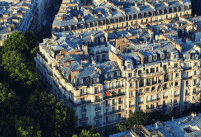VHM Saga – Episode 3 : The Golden Age
In the space of two decades, La Vieille Montagne zinc enjoyed unprecedented growth. It was the ideal material to meet the needs of Baron Eugène Haussmann, who would use it to cover the roofs of Paris and to enable rainwater recovery at roof level, an innovation that was life-changing for Parisians!
A coup d’état that was game-changing for zinc
Let’s go back to 2 December 1851. The Duke de Morny was plotting to stage and succeed the coup d’état that brought an end to the 2nd Republic (which only lasted four years).
His half-brother, Louis-Napoleon Bonaparte, who was president at the time, became Emperor of France. This coup was extensively financed by Fanny Le Hon–Mosselman, the beautiful wife of the Belgian ambassador, and sister of the director of the “Société des Mines et Fonderies de la Vieille Montagne”, founded in 1837. From the outset of Napoleon III’s reign, La Vieille Montagne benefitted from his support!
The Emperor, influenced by the health trends of the period, and also eager to consolidate his power with a fully-fledged capital city, wanted to transform Paris.
In the middle of the 19th century, part of the city still looked like a mediaeval town, with its narrow streets and steep-pitched roofs of flat tiles. Fires occurred frequently, with the promiscuity and dilapidation of the buildings were conducive to high levels of squalor.
In 1853, Napoleon III appointed Baron Eugène Haussmann Prefect of the Seine. The latter had already forged a fine reputation for himself as a man of authority and efficiency in the provinces. Napoleon III set him the objective of cleaning up the city and intensifying the restructuring programmes of his predecessors Rambuteau and Berger.
A new profession working for urban renewal in Paris
In Paris, Haussmann and his teams did not fuss over details. For the next seven years, they changed the city from top to bottom – literally so in terms of our zinc – by imposing large-scale buildings whose roofs featuring the famous “Mansard” frames, which were more cost-effective than the old steep-pitched tiled roofs, made zinc a huge success. (See the “Mansard” roof).
What was the reason for this? The Mansard roof features a lower slope of gambrel roof (steep-pitched lower part) and a pitched terrace whose low slope can only be covered by a large-sized metal material.
Lead is too heavy and copper is too expensive. Zinc is the perfect solution.
The material also became widespread in another application: rainwater recovery. This was apparently thanks to an idea of the Belgian ambassador’s wife.
Apparently the latter gave the idea to the Prefect of Paris, via the Duke de Morny, of installing gutters at the bottom of the slopes to avoid degradation of facade renderings that were regularly drenched by the rainwater flowing off the eave coursing tiles and blown onto the building by the wind.
In 1862, an official decree imposed the use of “recovery systems for street-facing facades”, in order to prevent passers-by being drenched by the falling rainwater!
This was a clever and effective move to promote “La Vieille Montagne” and significantly increase sales of zinc, which were now doubling by the decade.
Apart from these technical aspects, the huge success of La Vieille Montagne zinc was a result of a combination of several other factors: political factors (embellishment of PARIS in keeping with the new Emperor’s ambitions, the decision to better control uprisings via the creation of large wide boulevards…), health factors ( eradication of disease and of the risk of epidemics…), urban factors (enhancement of monuments, building development with the construction of blocks of rental properties…), economic factors (development of markets and places of trade, infrastructures, stations and industrial buildings;..), technological factors (industrial revolution, steam engines and electricity…) and social factors (demographic growth, comfort of inhabitants….)
In less than 17 years, Haussmann made his mark on the capital. Paris was roofed with La Vieille Montagne zinc. The new zinc-roofer profession took off. The motifs of stone ornaments were reproduced in metal (picture of the dormer window). Specialised workshops were created and competed with their skills to clad public buildings. (Look at the picture of the Grand Palais!)
Zinc acquires the status of a modern, international material
When Napoleon III left power in 1870, zinc no longer needed any help to be specified. In the last quarter of the century, the industrial revolution transformed society. Metal and glass architecture took over and zinc became a modern material.
During the 1889 Universal Exposition, at the time the Eiffel Tower was built, La Vieille Montagne was already producing over 90,000 tons of rolled zinc, 40% of which was used for domestic purposes that have since disappeared (garden boxes, basins, jugs, pitchers, watering cans, credences, tables and counter tops…)
During the second half of the 19th century, less well known and less visible than the roofs of Paris, engineers and operators worked to develop the quality and quantity of zinc. Installation techniques, some of which are still used today, were defined in close collaboration with the new zinc-roofers’ profession. In the wake of the Duke de Morny’s diplomatic tours, the sales teams at La Vieille Montagne created trading posts in the United States, in Pennsylvania and New Jersey, as early as 1850.
In the 1880s, La Vieille Montagne started selling its zinc in Saint Petersburg in Russia, and in Buenos Aires in Argentina.
In the next episode, we will have a look at the sourcing of zinc ore during this period of strong growth and we will be talking again about the fabulous history of the Altenberg mine and the neutral territory of Moresnet.


